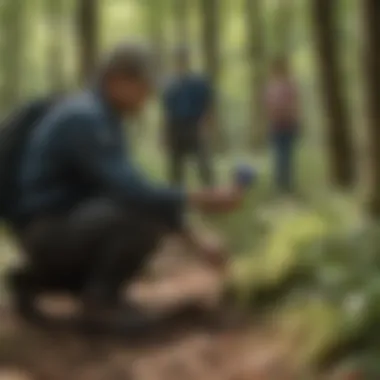Watersmeet Michigan: A Model of Woodland Stewardship


Intro
Watersmeet, Michigan, is a small community nestled in the Northwoods, surrounded by vast forests and rich biodiversity. The area is distinguished not just by its scenic beauty but also by its strong commitment to woodland stewardship and sustainable forestry practices. These elements are vital in understanding the ecological health of the region and the role of local stakeholders in conservation efforts. The community’s engagement in preserving these woodlands illustrates a broader lesson in ecological and community responsibility, a theme that echoes throughout this article.
This exploration delves deep into the intricacies of woodland ecosystems and the sustainable practices employed to protect them. In doing so, it examines how residents of Watersmeet navigate their environmental challenges while promoting a culture of stewardship that is both innovative and rooted in tradition. By linking ecological significance with community involvement, this article offers a nuanced understanding of how Watersmeet serves as a model for similar regions.
Understanding Woodland Ecosystems
Importance of Biodiversity in Forests
Biodiversity is a cornerstone of healthy woodland ecosystems. In Watersmeet, a variety of species coexist, each playing a definite role in maintaining ecological balance. The rich array of flora and fauna not only enhances the beauty of the landscape but also contributes to the resilience of the ecosystem. Higher biodiversity can lead to increased productivity and more robust ecological interactions, ensuring that the forest can withstand disturbances such as disease or climate change.
Local efforts aim to protect this biodiversity through education and community involvement. Landowners and stakeholders engage in practices that support native species and control invasive ones. This dynamic ensures that the ecological integrity is preserved.
Role of Forests in Climate Regulation
Forests play a critical role in mitigating climate change by acting as carbon sinks. The trees in Watersmeet absorb carbon dioxide from the atmosphere, reducing greenhouse gases. Moreover, forests regulate local climates by influencing weather patterns, maintaining moisture levels, and providing shade. In this sense, safeguarding forests is not just about maintaining local environments but also addressing global climate challenges.
Sustainable Forestry Practices
Principles of Sustainable Forestry
Sustainable forestry combines ecological health, economic viability, and social responsibility. It aims to meet current timber needs while ensuring future generations can also benefit from these resources. Key principles include:
- Maintaining Ecological Balance: Preserving wildlife habitats and water quality.
- Community Involvement: Engaging local populations in decision-making processes.
- Long-Term Planning: Developing management plans that consider the future of forests.
These principles guide Watersmeet’s approach to forestry, facilitating practices that are beneficial to both the environment and the economy.
Case Studies of Successful Implementations
A number of initiatives highlight Watersmeet's commitment to sustainable forestry. For instance, community forest management programs involve local residents in monitoring forest health and participating in selective logging practices that minimize impact.
Furthermore, partnerships with organizations like the U.S. Forest Service have enabled regional educational programs focused on responsible forestry practices. These efforts have yielded positive results in both timber yield and ecological restoration, showcasing a model for other communities.
Woodland Stewardship Techniques
Forest Management Plans
Forest management plans are essential for maintaining the health of woodland areas. In Watersmeet, such plans outline specific strategies for land use, habitat improvement, and resource conservation. These plans encourage foresters to use adaptive management techniques, allowing for adjustments based on ecological assessment and changing conditions.
Conservation Strategies
Effective conservation strategies provide a framework for preserving the integrity of natural resources. These strategies may include:
- Reforestation: Planting native trees in deforested areas.
- Controlled Burns: Using fire as a tool to manage undergrowth and promote healthy ecosystems.
- Community Education: Hosting workshops and seminars to inform residents about preserve management.
Each of these strategies not only aids in conservation but also fosters a sense of ownership and responsibility among community members regarding their environment.
Foreword to Watersmeet, Michigan
Watersmeet, Michigan, is a remarkable example of woodland stewardship in the Northwoods, drawing attention for its unique ecological and cultural landscape. This section highlights why understanding Watersmeet is essential in discussing broader themes of sustainable forestry and conservation. The area not only showcases the importance of forests in maintaining biodiversity but also illustrates how community efforts can significantly impact environmental practices.


Understanding the geographical and historical context of Watersmeet sets the stage for examining the ecological nuances of the region. The interplay between human initiatives and the natural environment in this municipality offers insights useful for forestry professionals and academics alike. This region's exemplifies how local stewardship can effectively merge economic needs with environmental protection.
Geographical Context
Watersmeet is located in Gogebic County, nestled within the expansive northern landscapes of Michigan. Surrounded by vast stretches of forested land, this municipality is characterized by its rich lakes and rivers. The Ottawa National Forest lies to the west, serving as a crucial habitat for diverse wildlife. Various ecosystems coexist here; from wetlands to mature forest stands, each contributes to the area's ecological health.
The geography supports a blend of flora and fauna. Notably, the land features species such as northern white cedar and sugar maple, which are integral to the local ecosystem. The lakes and rivers provide a habitat for aquatic species, further enhancing biodiversity. Although limited, human infrastructure exists primarily around essential services, which encourages a low-impact lifestyle in harmony with nature.
Historical Background
The history of Watersmeet is closely tied to the indigenous populations who first inhabited the region. Anishinaabe tribes, such as the Ojibwe, have lived in this area for centuries, managing the land through traditional practices that respect the ecosystem. Their relationship with the forests and waters showcases a model of sustainable living that modern conservation efforts aim to emulate.
Throughout the late 19th and early 20th centuries, the area saw increased logging activities, which transformed the landscape significantly. Following this period of extensive resource extraction, more recent trends have shifted toward rehabilitation and conservation. The community's growing awareness of ecological issues has led to various initiatives focused on restoring forest health and maintaining biodiversity. Today, the mixture of history and modern conservation strategies provides a rich narrative for understanding Watersmeet's ecological identity.
"Understanding the past informs the future of conservation efforts in Watersmeet, emphasizing the importance of both heritage and ecological balance."
This introduction serves as a foundation for exploring subsequent sections that delve into the ecological environment, community conservation, and sustainable forestry practices in and around Watersmeet.
Ecological Environment
The ecological environment of Watersmeet, Michigan, plays a fundamental role in understanding the region’s commitment to woodland stewardship. This area is not only seen as a collection of trees and wildlife but as a dynamic system that supports biodiversity, insulates water resources, and engages community efforts in sustainable practices. By examining its intricate web of life, one can better appreciate the intrinsic value of these ecosystems and the necessity for their protection and management.
Local Flora and Fauna
Watersmeet is home to a diverse range of flora and fauna that characterize the unique Northwoods ecosystem. The coniferous and deciduous trees, such as Eastern White Pine and Sugar Maple, form the forest canopy, providing habitat for numerous species. Among the local wildlife, one can find deer, black bears, and various birds, like the Common Loon and Blue Jay.
The intricate relationships in this ecosystem support not only the forest health but also the recreational and economic activities that rely on them. For example, the seasonal migration of birds and the population fluctuation of mammals are indicators of environmental health. In addition, rare species and their habitats must be monitored as they often face decline from climate change and habitat encroachment.
Health of Woodland Ecosystems
Maintaining the health of woodland ecosystems is paramount for the overall balance of the environment in Watersmeet. These ecosystems contribute to air and water purification, carbon sequestration, and soil stabilization.
The forest’s health can be measured through various indicators:
- Biodiversity: A rich variety of species often signifies a healthy ecosystem.
- Soil Quality: Healthy soil supports plant growth and helps mitigate erosion.
- Water Quality: Healthy woodlands filter pollutants and regulate the water cycle.
According to recent studies, the health of woodland ecosystems in Watersmeet shows signs of stress due to both anthropogenic and natural factors. While efforts exist to restore and maintain these ecosystems, more work and research are required to adapt to changing conditions.
"Sustainable forestry practices are essential to ensuring the longevity of woodland ecosystems, balancing human needs with the needs of the environment."
In summary, understanding the ecological environment in Watersmeet is critical to grasping the broader implications of woodland stewardship. Integrating conservation practices with community projects only enhances the resilience of these vital ecosystems.
The Role of Community in Conservation
Community involvement is a crucial factor in the conservation of woodland ecosystems in Watersmeet, Michigan. Fostering local engagement creates a collective effort where individuals and groups unite to safeguard the natural environment. This synergy often leads to better environmental outcomes and enhances stewardship practices. Getting community members engaged can also lead to a deeper understanding of local ecological issues, empowering people to take action. This section explores how such grassroots initiatives have built resilience in the face of environmental challenges.
Community Organizations and Initiatives
In Watersmeet, several organizations play an instrumental role in promoting conservation efforts. These organizations vary in focus and methodology but share a common goal of enhancing woodland stewardship. One key player is the Watersmeet Area Community Foundation, which actively supports local initiatives aimed at ecological preservation.
The foundation funds a range of projects, including stripping invasive plant species and restoring native habitats. Their commitment ensures that community members directly participate in decision-making processes. This fosters a sense of ownership, increasing the likelihood of successful outcomes.


Additionally, the Northwoods Alliance focuses on broader regional efforts, uniting various stakeholders. They work on sustainable land use projects, offer educational workshops, and promote collaboration between different community entities. Their initiatives provide vital resources for anyone interested in enhancing woodland health.
"Local engagement amplifies the impact of conservation efforts, ensuring that decisions resonate with the community's needs and values."
Volunteer Programs and Engagement
Volunteering strengthens community ties and raises awareness about environmental conservation. In Watersmeet, numerous volunteer programs allow residents to participate actively in restoration projects and educational endeavors. These programs encompass tree planting activities, trail maintenance, and educational workshops aimed at various age groups.
For example, the local chapter of the American Forests Society regularly hosts tree planting events. These initiatives not only restore native vegetation but also enable volunteers to learn about forestry practices and ecological functions. Moreover, engaging youth through such programs instills a sense of responsibility for their surroundings, fostering stewardship from a young age.
Social media platforms, such as Facebook, are also leveraged to promote volunteer efforts and share success stories. These avenues of communication increase involvement, as residents become more informed about ongoing initiatives.
Through these organized efforts, the community not only gains hands-on experience but also cultivates a culture of stewardship that is essential for sustainable forest management.
Sustainable Forestry Practices
Sustainable forestry practices are critical to maintaining the ecological health of woodland environments like those found in Watersmeet, Michigan. These practices not only preserve biodiversity but also ensure that forest resources are available for future generations. Understanding the significance of sustainable forestry is key for both local communities and stakeholders in the forestry sector. By implementing techniques that minimize environmental impact, a balance can be achieved between economic interests and conservation efforts. This section will explore sustainable techniques along with case studies that illustrate how these practices are applied in the region.
Overview of Sustainable Techniques
Sustainable forestry encompasses various techniques aimed at managing forest resources while maintaining their health and productivity. Some important sustainable techniques include:
- Selective logging: This method involves harvesting only certain trees from a forest, which helps to preserve the overall ecosystem and allows remaining trees to flourish.
- Reforestation and afforestation: Planting new trees in areas that have been harvested or in degraded landscapes fosters biodiversity and contributes positively to the carbon cycle.
- Agroforestry: Integrating trees into agricultural landscapes promotes soil health and provides economic benefits to farmers while also supporting local wildlife.
- Reduced-impact logging: This practice involves careful planning to minimize damage to surrounding vegetation and soil during logging activities, ensuring the forest's resilience.
In adopting these techniques, Watersmeet's forestry operations can contribute to a sustainable future while also meeting market demands. The benefits of sustainable forestry extend beyond the economic; they also include enhanced recreational opportunities, improved water quality, and increased resilience against climate change.
Case Studies from the Region
Examining successful case studies from the Watersmeet area provides insight into how sustainable forestry practices can yield positive outcomes. Several initiatives in the region highlight these benefits:
- Ottawa National Forest: This federal forest has implemented various sustainable logging practices. By focusing on selective logging and habitat restoration, they have successfully maintained biodiversity and forest health.
- Leelanau Peninsula Conservation: This initiative combines community efforts and sustainable practices to enhance forest ecosystems. They involve local residents in reforestation projects and educational programs promoting sustainable forestry.
- Chippewa National Forest: This forest has adopted reduced-impact logging techniques. Such approaches have not only safeguarded the ecosystem but have also improved the economic viability of local timber operations.
These examples illustrate that sustainable forestry practices can be effective in balancing ecological health with economic needs. As communities engage in such practices, they contribute to the long-term stewardship of forest resources in Watersmeet and beyond.
Challenges to Woodland Stewardship
In the context of Watersmeet, Michigan, addressing the challenges to woodland stewardship is crucial in preserving the ecological integrity of its forests. This region faces multiple hurdles that affect forest management and the overall health of woodland ecosystems. Understanding these challenges helps stakeholders devise strategies that can ensure the sustainability and resilience of these natural resources.
Impact of Climate Change
The realities of climate change pose serious threats to the forests of Watersmeet. Rising temperatures, changing precipitation patterns, and increased frequency of severe weather events can alter the delicate balance of local ecosystems. Forest health is compromised as species that are not suited for the new climate conditions struggle to survive. Additionally, pests and diseases can flourish in warmer climates, leading to higher mortality rates in vulnerable species.
Forest management practices must adapt to these changes. Forest owners need to consider climate-resilient species when planning reforestation efforts. Furthermore, access to reliable data on climate trends becomes essential for making informed decisions about land use and conservation efforts. Embracing adaptive management principles and integrating climate science with forestry practices are critical for future success.
"Understanding local ecosystem responses to climate change is vital for effective woodland stewardship strategies."
Economic Pressures on Forestry
In any discussion about woodland stewardship, economic factors cannot be overlooked. The forests of Watersmeet are under pressure from various economic forces that can lead to unsustainable practices. Increased demand for timber, recreational land, and development threatens the long-term viability of these woodlands.
Local logging practices often focus on short-term gains rather than sustainable harvesting methods. This may result in overexploitation of certain species and habitat degradation. As a result, the ecological balance is disrupted, leading to a decline in biodiversity and health of the forest ecosystems.


Engaging with the community and stakeholders to promote responsible forestry practices can mitigate these pressures. Developing markets for sustainably harvested wood, supporting local environmental initiatives, and providing educational resources on sustainable practices can align economic interests with ecological stewardship.
In summary, both the impact of climate change and economic pressures present formidable challenges to woodland stewardship in Watersmeet. Addressing these challenges with comprehensive strategies is essential to safeguard the ecological and cultural significance of its forests.
Cultural and Spiritual Significance
The cultural and spiritual significance of forests extends beyond their ecological function. This aspect is particularly prominent in Watersmeet, Michigan, where the connection between the land and the communities that inhabit it is profound. For many, these woodlands are repositories of heritage, a source of identity, and places of reflection.
Historically, indigenous communities have held deep reverence for forests. Their relationship to the land is not merely one of use but of respect and stewardship. Understanding these perspectives is essential to grasp how the community views their role in woodland conservation.
Indigenous Perspectives on Forests
The indigenous tribes in the Watersmeet area, such as the Lac Courte Oreilles Band of Lake Superior Chippewa Indians, have long recognized the sacred nature of the forests. For them, the land is not a commodity, but a living entity deserving of care and respect. Traditional teachings emphasize harmony with nature, guiding practices in resource management that prioritize sustainability.
The significance of forests within indigenous cultures often includes spiritual rituals, stories, and teachings passed down through generations. The trees, wildlife, and overall ecosystem are interwoven in the tribal narratives which illustrate the necessity of preserving these natural landscapes. Understanding this connection can lead to more inclusive conservation strategies which respect and incorporate these valuable insights.
"The forest is not a place to just take from; it is a partner in survival."
— Indigenous Elder
Historic Practices and Modern Applications
Historic practices in forest management, initiated by indigenous populations, have many implications today. Methods such as controlled burns, selective harvesting, and the understanding of biodiversity are rooted in ancient knowledge but gain new relevance in modern conservation efforts. These practices ensure ecological balance and promote resilience against threats like climate change.
Today, there is a growing recognition of the value of integrating traditional ecological knowledge with contemporary conservation strategies. Not only does this approach provide a holistic view of forest management, but it also fosters collaboration between indigenous peoples and modern forestry professionals.
As resource managers and local communities increasingly see advantages in this synergy, the methods borne from ancestral wisdom are finding new life. Incorporating traditional storytelling, land practices, and respect for the land leads to enhanced conservation success.
In summary, the cultural and spiritual significance of forests in Watersmeet serves as a vital reminder that effective stewardship requires a multifaceted understanding. This perspective not only enriches current forestry practices but ensures that the values and beliefs of the indigenous peoples are honored and preserved.
Future Directions for Watersmeet
The exploration of future directions for Watersmeet, Michigan is crucial in understanding how woodland stewardship can evolve. With increasing environmental concerns and socio-economic changes, it is essential to consider innovative practices and partnerships that can enhance conservation efforts. Addressing these factors is vital not only for the sustainability of the forests but also for the well-being of the community that relies on them. A forward-thinking approach can ensure that both ecological integrity and economic viability are upheld in harmony.
Innovations in Woodland Management
Innovations in woodland management represent a dynamic shift in how forestry practices are conducted. New technologies and methodologies are emerging, driving more efficient and sustainable approaches to forest management.
For example, the application of drone technology can provide detailed aerial assessments of forest health. This allows for better monitoring of tree growth, disease, and pest infestations. Additionally, remote sensing technology can assist in mapping areas that require reforestation or conservation efforts. These innovations can optimize resource allocation and improve overall management effectiveness.
Furthermore, the integration of adaptive management strategies is gaining traction. This involves a systematic approach to learning and adjusting techniques based on environmental responses. It enables managers to be more flexible and responsive to changes in ecosystem health. The benefits of these innovations lead to better decision-making and sustainability outcomes.
Potential Partnerships for Conservation
Establishing potential partnerships for conservation is vital for the success of woodland stewardship in Watersmeet. Collaborations between various stakeholders can amplify conservation efforts and distribute responsibilities more effectively. Strong relationships between community organizations, governmental agencies, and private landowners can foster a unified approach to managing the local woodlands.
- Local Community Groups: Engaging local organizations can mobilize citizen involvement in conservation initiatives.
- Educational Institutions: Partnering with universities or research centers offers access to valuable research and data that can guide practices.
- Nonprofit Organizations: Collaborations with nonprofits can attract funding and resources for conservation projects.
- Business Alliances: Engaging businesses that rely on forest resources for their supply chain can enhance sustainable practices.
These partnerships can create a shared vision for the future of Watersmeet’s woodlands. Through cooperation and mutual respect, diverse stakeholders can align their goals and work towards effective solutions that enhance ecosystem health.
"Collaboration is key to thriving ecosystems; strong partnerships help build resilient futures for our forests."
The End
The conclusion section serves as a vital synthesis of the insights discussed throughout the article, emphasizing the multifaceted importance of woodland stewardship in Watersmeet, Michigan. This area exemplifies how communities can engage in sustainable forestry practices that not only preserve the ecological integrity of the forests but also enhance the socio-cultural fabric of the region. By examining the relationship between the community and the natural environment, it becomes clear that collaborative efforts in conservation lead to more resilient ecosystems.
In summarizing key insights, we recognize that the interplay of local flora and fauna, the advocacy of community organizations, and historical perspectives greatly inform modern practices. Each factor intertwines, creating a holistic framework for understanding woodland health and sustainability. The clear correlation between active community engagement and effective conservation strategies highlights a repeated theme in the article.
Furthermore, as we confront challenges such as climate change and economic pressures, the case for sustained research and innovation becomes urgent. Increasing awareness about the fragile ecosystems and the pressures they face calls for ongoing dialogue among forestry professionals and academic researchers. In essence, this conclusion emphasizes both the accomplishments seen in Watersmeet and the work that remains ahead in ensuring its forests thrive for future generations.







